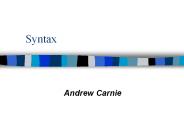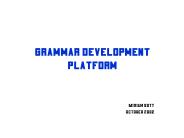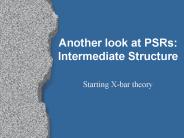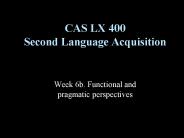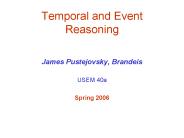Crosslinguistic PowerPoint PPT Presentations
All Time
Recommended
| PowerPoint PPT presentation | free to view
Spanish L1 Phonics ... Spanish Syllable Patterns ... Collapse English vowels into Spanish vowels, diphthongs or consonant blends. ...
| PowerPoint PPT presentation | free to view
They utilize translation & familiarity with cognates to support comprehension. ... Collapse English vowels into Spanish vowels, diphthongs or consonant blends. ...
| PowerPoint PPT presentation | free to view
sagittal. scan duration. TR. TE. slice thickness and spacing ... mid-sagittal slice. tongue shape. palatalization index = front cavity area = Results ...
| PowerPoint PPT presentation | free to view
Orthography: the marks of a writing system, including the spelling patterns of a ... Problems with Orthography. Word Identification (Decoding) ...
| PowerPoint PPT presentation | free to view
In research literature dealing with CLI, there are few constructive links to ... E. Rutberg, Robert D. Abbott, Noelia Garcia, Marci Anderson-Youngstrom, Allison ...
| PowerPoint PPT presentation | free to view
(A) in languages with no stress but with different rhythmic prominences such as ... motoric pattern of coordination and harmonization between mouth and hand. ...
| PowerPoint PPT presentation | free to download
Some crosslinguistic observations from the Asian languages group on principles of prosodic grouping
| PowerPoint PPT presentation | free to view
An XML-based internet database for general comparative linguistics ... Shared genetic endowment? Comparable functional pressure? Which combination of the two? ...
| PowerPoint PPT presentation | free to view
From typology to usage to cognition: How to explain crosslinguistic differences in descriptions of motion events Dan I. Slobin University of California, Berkeley
| PowerPoint PPT presentation | free to download
Title: How to characterize child language acquisition? Critical age hypothesis Imitation theory of acquisition assumptions; problems Reinforcement theory of ...
| PowerPoint PPT presentation | free to download
GreekGram Reporting on the progress of the implementation of a Modern Greek Grammar Fragment using the XLE parser Kakia Chatsiou achats@essex.ac.uk
| PowerPoint PPT presentation | free to download
Cross-linguistic influence (CLI) and transfer of learning Mark Andrew James Arizona State University [I]t is natural to wonder about the relation between language ...
| PowerPoint PPT presentation | free to view
Psych 56L/ Ling 51: Acquisition of Language Lecture 11 Development of Syntax & Morphology I
| PowerPoint PPT presentation | free to download
Evidence from the prosody-syntax interface. Focus ... Conflict systematically solved in favor of prosody. Italian focused subjects: Head-I EPP ...
| PowerPoint PPT presentation | free to view
Porter Stemmer Miriam Butt October 2003 Background Output Output Efficiency Algorithmic Method Basic Morphology Algorithmic Method Types of Errors Algorithmic Method ...
| PowerPoint PPT presentation | free to download
FHTW 2005. 1. Transcription, transliteration, transduction, and translation ... Machine learning. Statistical/stochastic approaches (e.g. n-grams) ...
| PowerPoint PPT presentation | free to view
Verb morphology is vulnerable in SLI. Explanations: locus of the problem either in representation or processing ... Mummy I orange-ACC ____ (press-PST.DI-1SG) ...
| PowerPoint PPT presentation | free to view
... research/theory on CLI might ... Communication, constructivism and transfer of knowledge in the education of bilingual learners. International Journal of ...
| PowerPoint PPT presentation | free to view
UC Berkeley / International Computer Science Institute. From ... Doggie bed. 0-9 months. Smiles. Responds differently to intonation. Responds to name and 'no' ...
| PowerPoint PPT presentation | free to download
Syntax Andrew Carnie The web page for this textbook Topic 1: Syntax: some background Q. What is Syntax?? The scientific study of sentence structure Perspective: The ...
| PowerPoint PPT presentation | free to download
Title: A quantitative grammar of a German/English mixed code, or the blueprint is not a red herring Author: Evi Eppler Last modified by: Richard Hudson
| PowerPoint PPT presentation | free to download
Title: WORD FORMATION PROCESSES Author: UNC CH Last modified by: della chambless Created Date: 9/21/1999 2:49:15 AM Document presentation format: On-screen Show (4:3)
| PowerPoint PPT presentation | free to download
Psych 56L/ Ling 51: Acquisition of Language Lecture 10 Lexical Development II * * * * * * * * * * * * * Superiority of using all the available information: Scenes ...
| PowerPoint PPT presentation | free to download
Test against more data. Scientific method. 1) John loves himself. 2) Mary loves herself. 3) John ... Match up a sentence that they hear with a situation in ...
| PowerPoint PPT presentation | free to view
www.ddl.ish-lyon.cnrs.fr
| PowerPoint PPT presentation | free to view
Program design should include: Ongoing assessment using multiple measures. Integrated schooling (all language learners together) High expectations by teachers
| PowerPoint PPT presentation | free to download
2. Today's lecture. introduce and define some terminology ... code-switching acquired very early (age 2;0) (see also Lanza 1992) ... M ller & Hulk (2001) ...
| PowerPoint PPT presentation | free to view
English: The pig loves the farmer. SV VO Agreement. German: Das ... for grammatical sentences in Russian, Hungarian, Spanish without the 'preferred cue' ...
| PowerPoint PPT presentation | free to view
L2-French (= other national language): Starts at age 8-9 (Year 3) ... Journal of French Language Studies14, 281-299. Chambers, F. (1997) ...
| PowerPoint PPT presentation | free to download
Collocations (MI score, T score, Loglikelihood) Equivalence classes: ... Collocations of words in the Russian class ?????? ?: ??? ?????? (quite), ????? ...
| PowerPoint PPT presentation | free to view
Machine Translation (French, English) Tree Banking (English, German) ... Applicational Advantage: machine translation is made easier. ...
| PowerPoint PPT presentation | free to download
The SIOP Model TESOL Instructional practices OUTLINE What is SIOP? What are its components? What struggle teachers with most? What are essential Lesson Plan components?
| PowerPoint PPT presentation | free to view
poems. Flat Structure. I bought the big [book of poems] with the red cover not the small [one] with the ... of poems. with the blue cover. PP. N' AP. big. N' ...
| PowerPoint PPT presentation | free to download
A word of thanks to those who have made this conference possible ... Martinet 1955; Clements 2003a, 2003b. 24. Markedness Avoidance: 'avoid marked feature values' ...
| PowerPoint PPT presentation | free to download
Babies can discriminate the sounds of all the world's languages and adults cannot. ... babies with two pictures: doll dog. 2. Present sentences: Where's the ...
| PowerPoint PPT presentation | free to view
Title: Wolfgang Wildgen Migration von Sprachen und Kulturen berlegungen zur kulturellen Dynamik von symbolischen Formen Author: Wolfgang Wildgen
| PowerPoint PPT presentation | free to download
Suggestions and gripes to: cpurrin1@swarthmore.edu ... A pilot study on content and polar interrogatives Julie Hansen Section for Linguistics, Department of ...
| PowerPoint PPT presentation | free to download
UC Berkeley / International Computer Science Institute. MOTHER: what are ... But Kids aren't born as blank slates! And they do not learn language in a vacuum! ...
| PowerPoint PPT presentation | free to view
it is confirmed by studies that smoking can cause the addictive and dependence, ... 1994: Word order and nominative Case in nonnative language acquisition: a ...
| PowerPoint PPT presentation | free to view
L1 transfer in SLA Adapted from Franceschina (2003) What is transfer? [transfer is evidenced as] those instances of deviation from the norms of either language ...
| PowerPoint PPT presentation | free to view
The younger the learner the more successful and faster L2 learning is (Lenneberg, ... receive distinctly different models for learning than girls (e.g. Moslem world) ...
| PowerPoint PPT presentation | free to view
CAS LX 400 Second Language Acquisition Week 6b. Functional and pragmatic perspectives What is a functionalist approach? Functionalist researchers ( functionalists ...
| PowerPoint PPT presentation | free to download
Frequency effects of metrical structure on the development of early PWs in Catalan and Spanish
| PowerPoint PPT presentation | free to view
Genitive-Possessive construction. How? Elicitation. Grammatical judgment. Frog story ... Genitive-Possessive construction. Method. 20. Selection of variables. Dutch ...
| PowerPoint PPT presentation | free to view
Title: GRS LX 700 Language Acquisition and Linguistic Theory Author: Paul Hagstrom Last modified by: Paul Hagstrom Created Date: 1/17/2001 3:53:12 PM
| PowerPoint PPT presentation | free to download
Breadth: the number of words the meaning of which one has at ... such as producing plafond ceiling', or professeur professor' for the stimulus profund deep' ...
| PowerPoint PPT presentation | free to view
manual (lists of synonyms in dictionaries), automatic similarity (Manning, Sch tze, 1999) ... Semi-automatic methods for generating examples in the two languages ...
| PowerPoint PPT presentation | free to view
There is no one correct perspective; rather, you should combine your own ... C. The only reason that some people cannot learn a second or foreign language is ...
| PowerPoint PPT presentation | free to view
roberta.tedeschi@let.uu.nl. Plan of the talk. Previous studies on the 'syntax-discourse' interface in Italian ... New experimental study: Choice of referring ...
| PowerPoint PPT presentation | free to view
Pronouns are packed with linguistic goodness of every possible type: Morphology ... West Country dialects' nominative object pronouns: Don't tell I, tell he! ...
| PowerPoint PPT presentation | free to view
Clark, Eve V. 1987. The principle of contrast: A constraint on language acquisition. ... Hillsdale, NJ: Lawrence Erlbaum. 31. Reference (6) Goldberg, Adele E. 1995. ...
| PowerPoint PPT presentation | free to view
Acquisition of vowel duration conditioning in Russian-Scottish ... intonation (Mennen, 2004); VOT studies (Caramazza et al. 1973; Flege, 1987; Williams, 1980) ...
| PowerPoint PPT presentation | free to view
Relationships between early infant speech segmentation skills and later narrative ability ... This may lead to greater ability to identify children at increased ...
| PowerPoint PPT presentation | free to view
Hemispheres Magazine, 2001. DISCOURSE STATUS ... Thanks to Boston University students in LS 751, Spring 2002, for discussions of ...
| PowerPoint PPT presentation | free to download
Yesterday John saw a girl who was running this morning. ... week /TIMEX2 the aged and ailing former Khmer Rouge leader had fled to China. ...
| PowerPoint PPT presentation | free to download





















